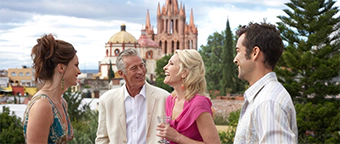San Miguel de Allende travel guide: the secret’s out on this arty Mexican city
Link to Actual Article: https://theweek.com/arts-life/travel/962145/san-miguel-de-allende-travel-guide-mexico
Outside of the Americas, San Miguel de Allende might just be the best kept secret in Mexico. Nestled deep in the Guanajuato central highlands of this vast country, surrounded by semi-arid desert and with no airport of its own, it takes some zooming in just to find it on Google Maps. So it’s little surprise it often slips through the knowledge cracks for those who’ve flown over an ocean.
Rosewood Mayakoba review: a stunning setting to rave aboutA gastronomic tour of Mexico City
Closer to home it’s a different story. The city has attracted a generation of visitors from the US who adore its fine climate and cultural peculiarity, inspiring some to write books about it. Even so, it has managed to remain virtually intact from its colonial peak in the mid-18th century when it became the first city in Mexico to gain independence. Time hasn’t quite forgotten San Miguel de Allende since, but it’s what every curious traveller dreams of: somewhere that’s enduringly one of a kind.
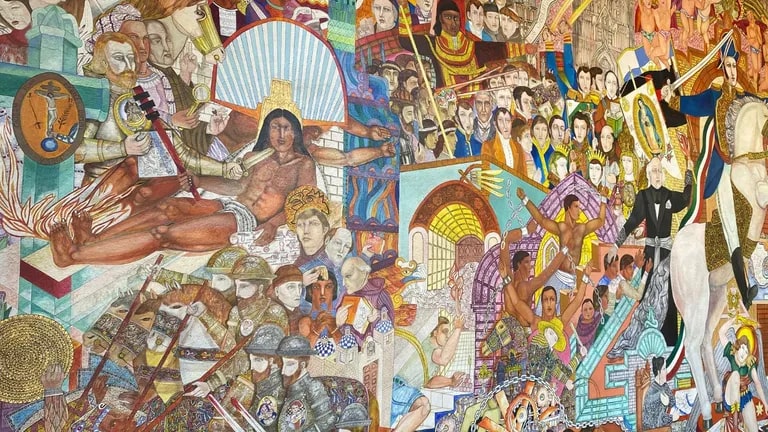
War of Independence mural in the Instituto Allende
(Image credit: Dominic Kocur)
Things to see and do
Considering its size and remoteness, San Miguel de Allende punches well above its cultural weight. Rarely have I found so many diverse artistic attractions in such a compact metropolis, with almost every one of its narrow, atmospheric streets home to numerous museums, independent galleries and exhibitions.
Galería Casa Diana is one of several reasons to explore Recreo street, which runs vertically through the city. It’s a stylishly cluttered haven for the psychedelic work of Jewish Mexican surrealist, Pedro Friedeberg. One of his iconic “hand-chair” sculptures can also be found in the nearby Parque El Chorro, which has marvellous views from its elevated position. At the opposite end of the city is Fábrica la Aurora, a mazey former textile factory now home to a colony of local artists and curators, all displaying and selling work that defies any kind of collective description.
But before you even reach the artistic riches that lie within, the architectural profile of San Miguel de Allende will leave you enthralled. If you’re a little rusty on colonial-era Mexico or the War of Independence, a few days in San Miguel de Allende is an immersive crash course. There’s a dramatic mural depicting the war in the Instituto Allende, an influential visual arts school housed in a splendid haçienda on Ancha de Antonio, which is free to enter and an absorbing introduction to the city’s historical significance.
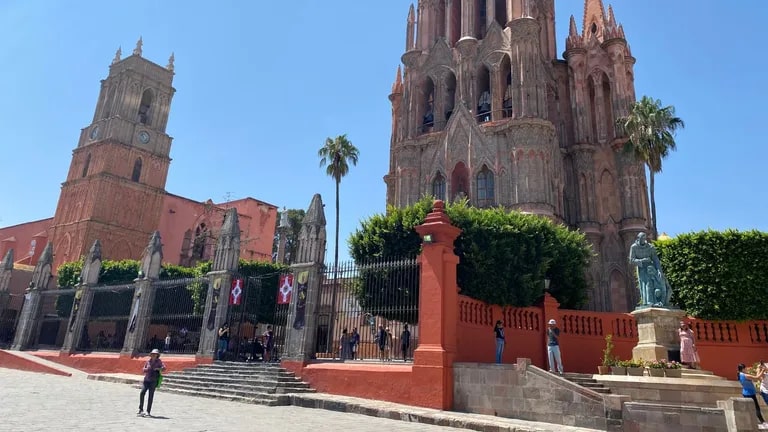
La Parroquia is the city's emblematic centrepiece
(Image credit: Dominic Kocur)
Even if the city entered a period of decline after the Spanish departed (assisted by two San Miguel natives the city was later renamed after), it didn’t deteriorate. Quite the opposite: the cityscape is an enchanting tapestry of ornate baroque villas, imposing haçiendas and – most recognisably – rambling terraces of low-slung, beautifully weathered colonial houses, all of which may not have survived an earlier revival with quite as much grace and integrity.
The aesthetic uniformity of these houses is its own poetic spectacle, a major reason why its historic core was designated a Unesco World Heritage Site in 2008. For this alone, days in San Miguel de Allende can be enjoyed freely roaming its cobbled back streets that slope up and down behind the main avenues of the city, lined with inviting artisanal shops all deserving of your business.
You can try going off-grid, but it can feel like all roads eventually lead to the city’s emblematic centrepiece, La Parroquia. Against a backdrop of infinite blue skies – allegedly a deeper blue than in other parts of Mexico – the soaring neo-Gothic church is an enigmatic shade of pink and dominates most vistas. At least for me, its intricately carved sandstone façade and ethereal silhouette was most evocative of Antoni Gaudí’s Sagrada Família in Barcelona, but its main architectural influence is Cologne Cathedral in Germany – just one of the city’s many curiosities.
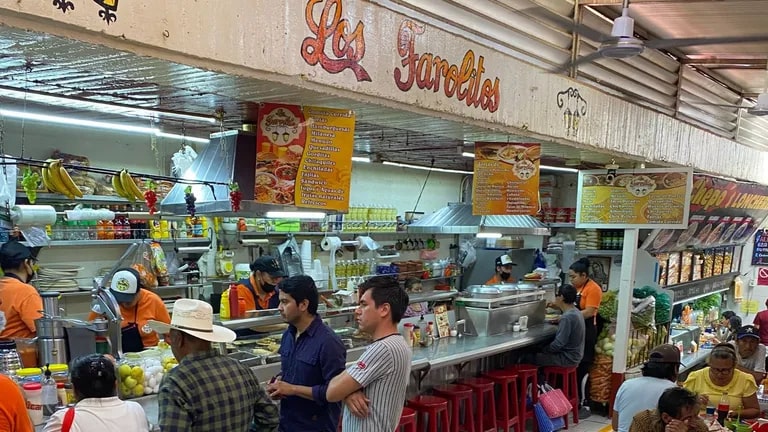
Ignacio Ramírez is one of the fascinating markets
(Image credit: Dominic Kocur)
Five minutes northeast of La Parroquia are two well-hidden but fascinating markets: Ignacio Ramírez and San Miguel. Together they form a rambunctious labyrinth of passageways and tunnels, bristling with local vendors selling everything from wrestling masks to obscure herbal remedies. Those might not top your shopping list, but a loosely defined section of the market is devoted to artisanal crafts. It’s here where your bags can quickly fill with lovingly handmade ceramics, jewellery and gifts perfect enough to counterweight the avalanche of photos and stories to unload on your nearest and dearest when you get home.
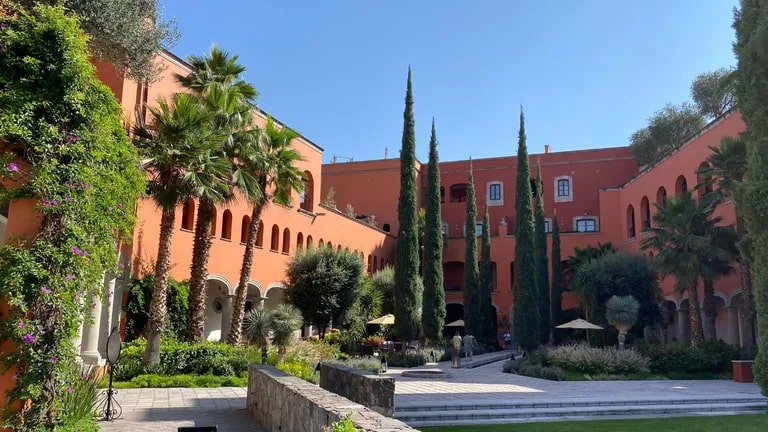
The courtyard at Rosewood San Miguel de Allende
(Image credit: Rosewood Hotels & Resorts)
Where to stay: Rosewood San Miguel De Allende
The Rosewood’s presence in San Miguel de Allende since 2011 is a fair indication of the city’s modern prosperity, which is in no small part down to its discovery by the American market decades earlier. Indeed, many Americans have relocated here for good, an idea I contemplated once or twice after its spell had been cast on me. Until then, Rosewood San Miguel de Allende remains the city’s most prestigious temporary address.
Authenticity is Rosewood’s raison d'être, but tuning in to San Miguel de Allende’s historically distinct frequency poses a unique challenge. It succeeds with trademark sophistication. The imposing haçienda-style building it occupies near Parque Juarez in the south of the city isn’t original, but it exudes a timelessness of character. The striking hue of the building’s outer stucco fluctuates from bright terracotta in the morning; rusted copper in the afternoon and, finally, deep, brick red at dusk. The verdant inner courtyard, part of the signature bar and restaurant, 1826, is a premium spot to observe this phenomenon.
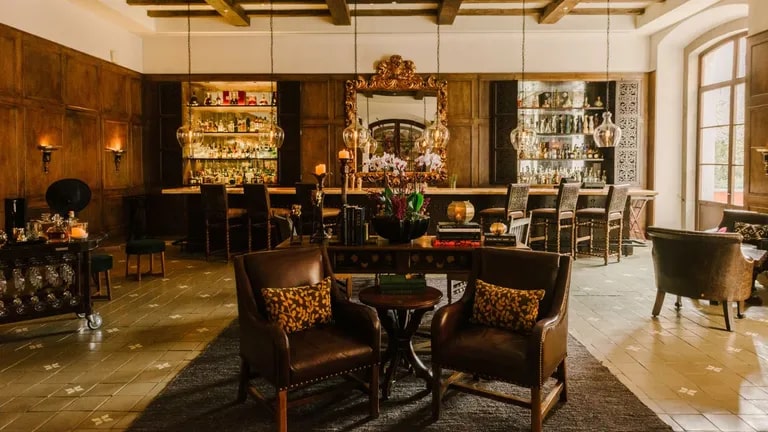
1826 bar and restaurant
(Image credit: Rosewood Hotels & Resorts)
Like the rest of the hotel, suites employ fine period furnishings with modern elegance. Carved ebony panelling, tobacco-hued leather upholstery and exposed stonework are offset by marble and an opulent sense of volume. Service is polished but with comforting familiarity, as if you’re a regular guest in the most palatial of family homes. All categories come with terraces to conduct the earliest beams of Guanajuato sun, but the hotel’s achingly fashionable pool area, rooftop bar and courtyard are among the most blissful outdoor spots anywhere in San Miguel De Allende.
The fifth floor Sense spa offers personalised treatments in an environment that’s been fine-tuned to restore and revive. An equally rewarding, if more hedonistic, experience is the tequila tasting. Conducted by the hotel’s ebullient sommelier, Ricardo, you’ll be educated on Mexico’s most famous export and sample bottles from 1826’s A-list top shelf with carefully paired snacks. A flawlessly clear Casa Dragones Blanco with a delicate raw salmon cornetto is the gateway. Ricardo will enthusiastically describe the esoteric properties of each that follow, but fortune favours the curious: ask many questions to unlock a new frontier of agave-based knowledge.
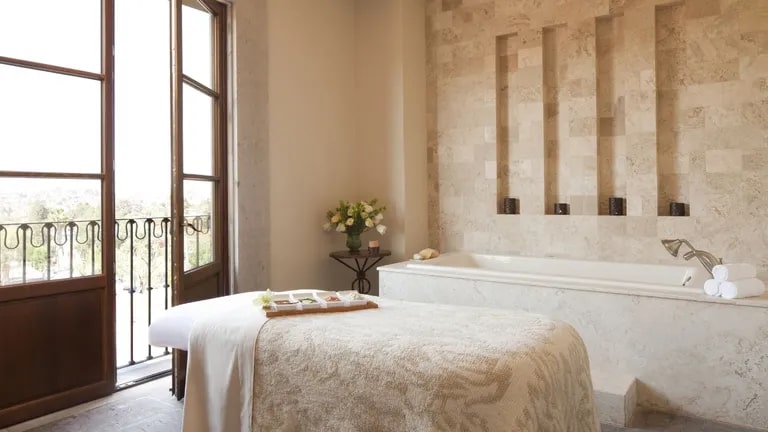
The hotel’s Sense spa
(Image credit: Rosewood Hotels & Resorts)
Eating and drinking
Even if you’re not staying at the Rosewood, don’t be shy: it offers some of the finest gastronomy in San Miguel de Allende for guests and non-guests alike. In fact, it can feel like most of the city flocks to Luna, its rooftop restaurant and bar, not least to gaze adoringly at the distant spires of La Parroquia at sunset – a moment of life-affirming privilege. Cocktails are mixed with flair and respect for tradition, making its artisanal creations on-par with the classics. The food menu duets comfortably with the Middle East, so you’ll find the fragrant notes of za’atar and harissa with Mexico’s more recognisable zing and fire. The Crudo de Camarones – raw shrimp ceviche with apple, grapes and ginger – is outrageously piquant.
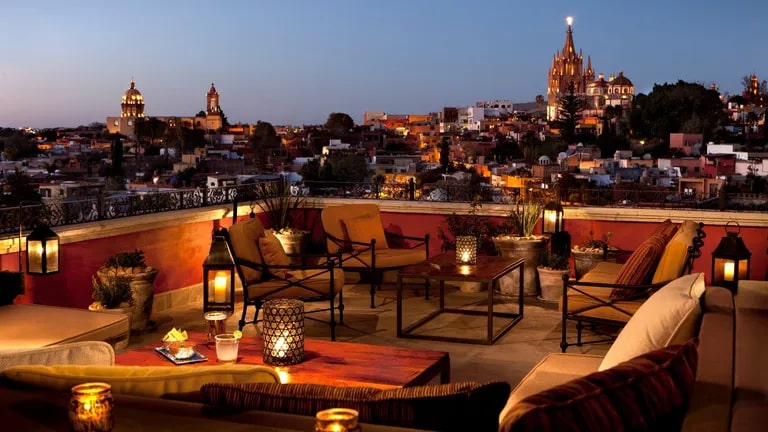
The Rosewood’s Luna rooftop restaurant and bar
(Image credit: Rosewood Hotels & Resorts)
At ground level, 1826, a name that commemorates the most formative year in the city’s history, unfurls from a plushly upholstered dining room into the courtyard and beyond, giving you the freedom to enjoy elevated regional specialities, like crisp-skinned striped sea bass with shrimp mole, under its beautiful chandelier or in a nook of the exquisitely manicured grounds of the hotel.
Beyond the refinement of the Rosewood, the city will satisfy the most primitive street food desires. Mercato Igancio Ramírez is where you can eat shoulder-to-shoulder with the locals. Ordering might be on blind faith if you don’t speak like a local, but rest assured everything is invariably as delicious as it smells. For a more tranquil experience, La Parada on Recreo is an ultra-authentic Peruvian restaurant with ceviche and pisco sours to die for. As it’s next door, it would be a crime not to pay San Mezcal a visit after. The eponymous spirit is purveyed with encyclopaedic range from all regions and agave types, but don’t miss anything made “ancestrally”, an ancient and nearly extinct production method.
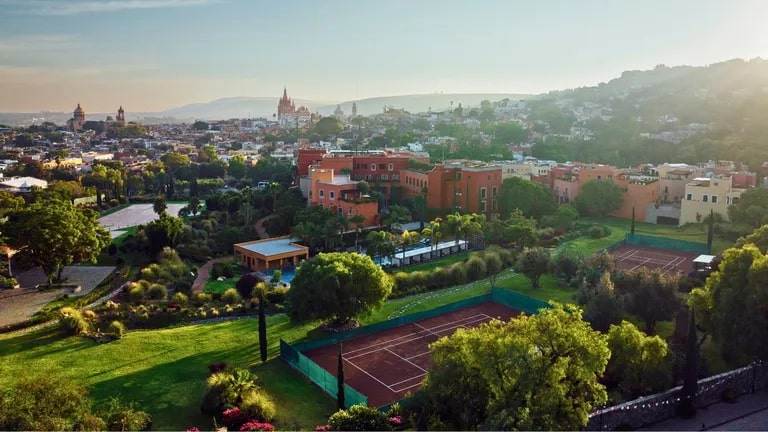
The Rosewood offers great views over San Miguel de Allende
(Image credit: Rosewood Hotels & Resorts)
How to get there
The flipside of San Miguel de Allende’s unspoiled condition is its accessibility. Sitting nearly equidistant between two international airports in different states, Bajío and Querétaro, each is roughly two hours away on wheels with little by way of a public transport option. Neither can be accessed directly outside the Americas so connecting from Texas, California or Chicago is necessary from further afield. But it’s not unreachable by car from Mexico City either, making it a convenient and wholly worthwhile detour for road trips involving the capital.
Dominic Kocur was a guest of Rosewood San Miguel De Allende. Nemesio Diez 11, Colonia Centro, San Miguel de Allende, GTO 37700 Mexico; rosewoodhotels.com


